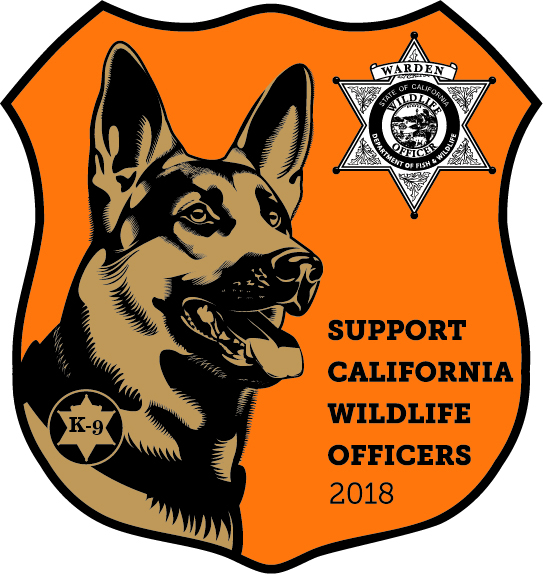
When Can I Get the 2018 Warden Stamp?

by Carrie Wilson
1-18-2018
Website
Question: I enjoy collecting the warden stamps (or decals) that come out every year. Is there a new edition coming out for 2018 soon? When will it be available? (Bridget)
Answer: Yes! The 2018 Warden Stamp is now available for $5 online at ca.wildlifelicense.com/internetsales, at any license sales agent or California Department of Fish and Wildlife (CDFW) sales counter, or at any of the upcoming sportmen’s shows (including the International Sportsmen’s Exposition this weekend in Sacramento). As you said, the “stamps” are actually decals that can be attached to vehicles, outdoor gear, etc. Initiated in 2010, the Warden Stamp program helps raise money to support the purchase of equipment and training for the state’s wildlife officers. It also provides funding for special law enforcement programs, including CDFW’s K-9 program. In fact, this year’s stamp pays homage to K-9 wildlife officers, with the image of a German shepherd dog at attention.
Selling Fishing Flies Made With Feathers or Hair
Question: Can waterfowl feathers be used to tie flies that are then sold, as long as the birds were legally taken? How about deer hair or any other animal parts used in fly tying? (John G.)
Answer: It is generally unlawful to sell, trade or purchase any species of bird or mammal – or their parts – found in the wild in California (Fish and Game Code, section 3039(a)) even if legally taken with a hunting license. The intent is to prohibit the commercialization of wildlife, which belongs to the citizens of the state of California and not any individual person to profit from. However, there are some limited exceptions that can apply to the making and selling of fishing flies.
California law does not specifically address waterfowl feathers, but federal law under the Migratory Bird Treaty Act does. It says any person may possess, purchase, sell, barter or transport for the making of fishing flies, bed pillows and mattresses, and for similar commercial uses the feathers of migratory waterfowl (ducks, geese, brant and swans) killed by hunting (Code of Federal Regulations Title 50, section 20.91).
California law also makes another exception that allows for the sale of deer skins or hides of any lawfully taken deer. Deer hides may be sold, purchased, tanned or manufactured into articles for sale (FGC, section 4303). That would cover fishing flies made and sold from lawfully taken deer. And since we’re on the subject of fly tying, elk hair is another popular material used in fishing flies. However, California law makes no exception for elk hides as it does for deer so it would be illegal to use the hair from an elk – even from one lawfully taken with a hunting license – to create fishing flies for commercial sale.
Turning turkey feathers into jewelry
Question: Can I use turkey feathers from domestically raised turkey farms to make jewelry? I know that Fish and Game Code, section 3039, limits the sale of wild animal parts, but section (d) appears to allow the sale of inedible parts of domestically raised game birds. (Nancy H.)
Answer: Yes, you may use turkey feathers from domestically raised turkey farms. Domestically raised turkeys are not wild birds, and therefore are not subject to the restrictions on the sale of wild bird parts found in FGC, section 3039.
Lead-free bullet casting alloy
Question: My question is regarding casting your own lead-free bullets. There is a company in California called ROTOMETALS that sells a lead-free bullet casting alloy that is 88 percent bismuth and 12 percent tin. Does this lead-free bullet alloy have to be certified by the state of California to be used for hunting? (Ron K.)
Answer: If you are making your own projectiles or ammunition and intend to hunt with those projectiles or that ammunition in a location where the hunting regulations require the use of nonlead projectiles or ammunition, you must follow the process set out in CCR Title 14, section 250.1(f), to get those projectiles or ammunition certified as nonlead by CDFW. A projectile is “any bullet, ball, sabot, slug, buckshot, shot, pellet or other device that is expelled from a firearm through a barrel by force.” (CCR Title 14, section 250.1(b)(1)). CDFW has tried to make the nonlead certification process as easy as possible. More information on the certification process, including a list of ammunition already certified as nonlead, is available on CDFW’s website.
Also, we recommend that you carry proof of the CDFW’s certification of your ammunition as nonlead with you in the field when you are hunting with ammunition that you made on lands where nonlead ammunition is required.
Carrie Wilson is a marine environmental scientist with the California Department of Fish and Wildlife. While she cannot personally answer everyone’s questions, she will select a few to answer each week in this column. Please contact her at CalOutdoors@wildlife.ca.gov.
Website Hosting and Design provided by TECK.net